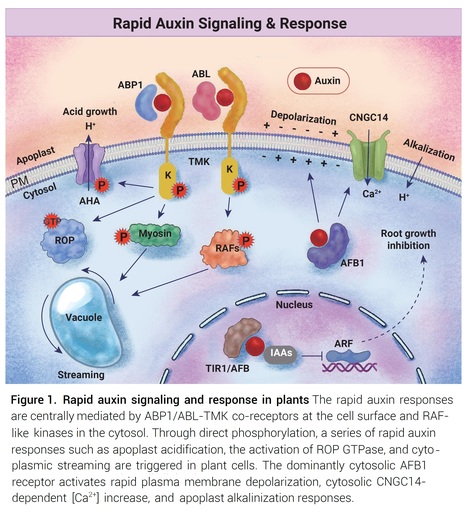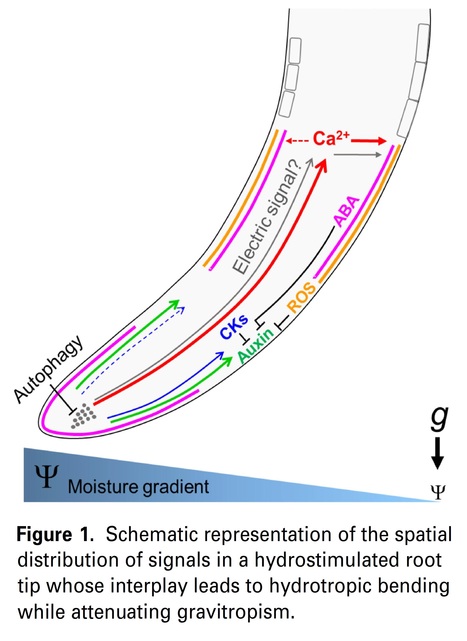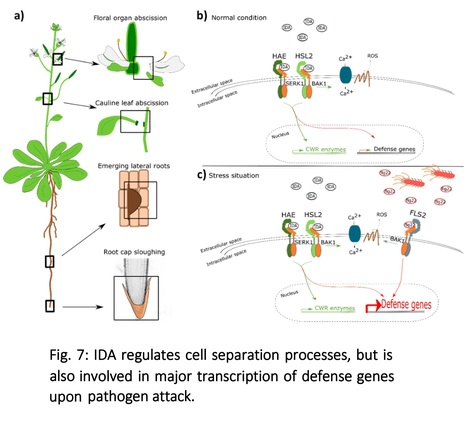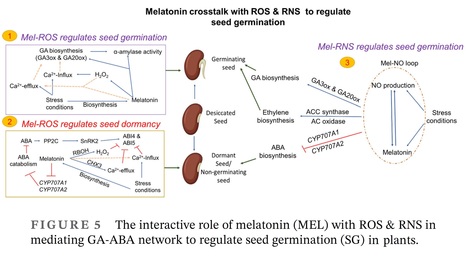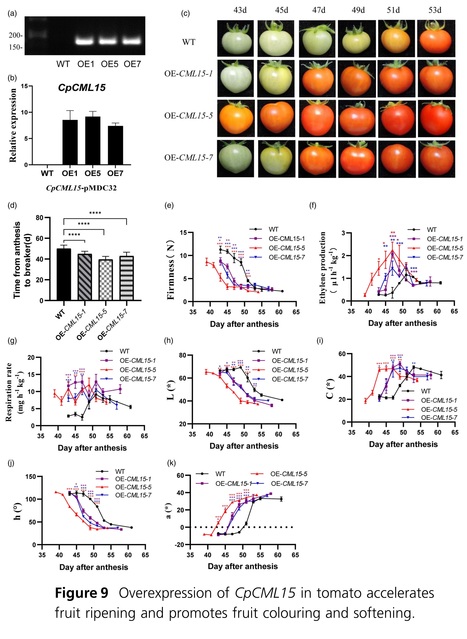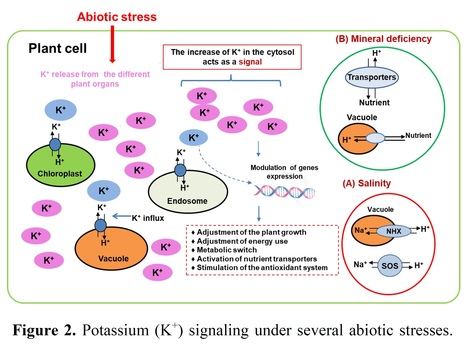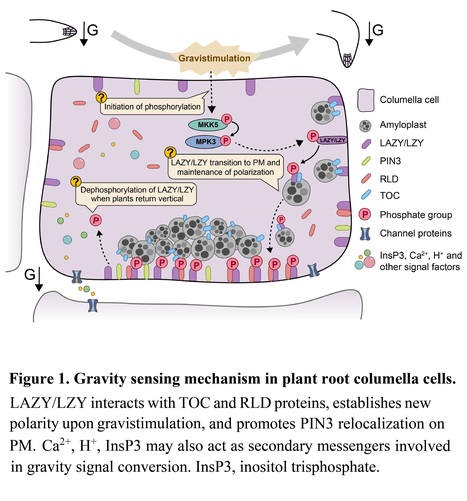 Your new post is loading...
 Your new post is loading...
Authors: Akbar Ali, Krishan Kant, Navneet Kaur, Shalu Gupta, Parnika Jindal, Sarvajeet Singh Gill and M. Naeem.
South African Journal of Botany (2024)
Highlights: • Salicylic acid (SA) has encouraging effects on the growth and development of plants. • SA stimulates signalling in plants via several stress proteins and genes. • SA positively interacts with other phytohormones. • SA enhances plant tolerance towards abiotic stress.
Abstract: "Drastic change in global climatic conditions has significantly increased the frequency of abiotic stresses, such as different temperature regimes (high, low, or freezing stress), uneven precipitation leading to flooding or drought, soil salinization, cyclones and hurricanes which pose a major challenge to the crop productivity and food security. Therefore, it becomes imperative for the global science community to engineer stress tolerance in crop plants to ensure enough food for the globe. Plant growth regulators play an important function in stress management. One putative plant hormone that aids plants in coping with biotic and abiotic stressors is salicylic acid (SA). SA also cooperates with other phytohormones, such as gibberellins, auxins, abscisic acid, jasmonic acid, ethylene, polyamines, nitric oxide, and to counter the negative effects of environmental perturbations. Moreover, SA shields plants from oxidative stress by reducing the production of reactive oxygen species in challenging circumstances. Additionally, SA stimulates gas exchange, photosynthesis, and osmolyte synthesis in plants, which counteract the damage caused by ROS. Exogenous application of SA to agricultural crops including medicinal and aromatic plants improves their abiotic stress tolerance, either individually or in combination with other phytohormones. SA can stimulate the production of secondary metabolites by controlling the expression of stress-related genes, activating or regulating several key enzymes, and balancing the ion content. The present review summarizes the various mechanisms by which SA confers abiotic stress tolerance in plants through homeostasis, signalling, and crosstalk with other phytohormones."
Authors: Yewei Zhou, Chunyan Wang, Yongqiang Yu, Zhaojun Ding and Tongda Xu.
The Innovation Life (2024)
Abstract: "Rapid auxin responses in plants are crucial in initiating cellular changes. These responses are involved in processes such as plasma membrane depolarization, cytoplasmic streaming, apoplastic pH changes, calcium influx, etc. Recent studies illustrated how auxin triggers rapid changes in protein phosphorylation in different species through both the ABP-TMK auxin perception at the cell surface and a conserved RAF-like kinase-based mechanism. These works uncovered an ancient system for rapid responses to the auxin signaling molecule, shedding light on its profound impact on various cellular pathways and functions."
Authors: Chao Wang, Ren-Jie Tang, Senhao Kou, Xiaoshu Xu, Yi Lu, Kenda Rauscher, Angela Voelker and Sheng Luan
Nature (2024)
One-sentence summary: A study of calcium homeostasis in the plant Arabidopsis reveals two signalling pathways it uses to balance the objectives of growth and immunity by regulating the level of Ca2+ in the cytosol.
Abstract: "Calcium (Ca2+) is an essential nutrient for plants and a cellular signal, but excessive levels can be toxic and inhibit growth1,2. To thrive in dynamic environments, plants must monitor and maintain cytosolic Ca2+ homeostasis by regulating numerous Ca2+ transporters3. Here we report two signalling pathways in Arabidopsis thaliana that converge on the activation of vacuolar Ca2+/H+ exchangers (CAXs) to scavenge excess cytosolic Ca2+ in plants. One mechanism, activated in response to an elevated external Ca2+ level, entails calcineurin B-like (CBL) Ca2+ sensors and CBL-interacting protein kinases (CIPKs), which activate CAXs by phosphorylating a serine (S) cluster in the auto-inhibitory domain. The second pathway, triggered by molecular patterns associated with microorganisms, engages the immune receptor complex FLS2–BAK1 and the associated cytoplasmic kinases BIK1 and PBL1, which phosphorylate the same S-cluster in CAXs to modulate Ca2+ signals in immunity. These Ca2+-dependent (CBL–CIPK) and Ca2+-independent (FLS2–BAK1–BIK1/PBL1) mechanisms combine to balance plant growth and immunity by regulating cytosolic Ca2+ homeostasis."
Authors: Yonatan Wexler, Julian I. Schroeder and Doron Shkolnik.
The Plant Journal (2024)
Significance Statement: Understanding the mechanisms that plant roots utilize to resist the strong tendency to grow downward in order to grow toward a moisture source, holds great potential for unveiling research approaches and technologies to improve crop performance. Herein, we assess the complex interplay between major regulators of root growth, development, and responses to myriad internal and external cues, that function to attenuate downward root growth, thereby enabling the root to reach water.
Abstract: "Plants partly optimize their water recruitment from the growth medium by directing root growth toward a moisture source, a phenomenon termed hydrotropism. The default mechanism of downward growth, termed gravitropism, often functions to counteract hydrotropism when the water-potential gradient deviates from the gravity vector. This review addresses the identity of the root sites in which hydrotropism-regulating factors function to attenuate gravitropism and the interplay between these various factors. In this context, the function of hormones, including auxin, abscisic acid, and cytokinins, as well as secondary messengers, calcium ions, and reactive oxygen species in the conflict between these two opposing tropisms is discussed. We have assembled the available data on the effects of various chemicals and genetic backgrounds on both gravitropism and hydrotropism, to provide an up-to-date perspective on the interactions that dictate the orientation of root tip growth. We specify the relevant open questions for future research. Broadening our understanding of root mechanisms of water recruitment holds great potential for providing advanced approaches and technologies that can improve crop plant performance under less-than-optimal conditions, in light of predicted frequent and prolonged drought periods due to global climate change."
Authors: Vilde Olsson Lalun, Maike Breiden, Sergio Galindo-Trigo, Elwira Smakowska-Luzan, Rüdiger Simon and Melinka A. Butenko.
bioRxiv (2024)
Abstract: "The abscission of floral organs and emergence of lateral roots in Arabidopsis is regulated by the peptide ligand INFLORESCENCE DEFICIENT IN ABSCISSION (IDA) and the receptor protein kinases HAESA (HAE) and HAESA-LIKE 2 (HSL2). During these cell separation processes, the plant induces defense-associated genes to protect against pathogen invasion. However, the molecular coordination between abscission and immunity has not been thoroughly explored. Here we show that IDA induces a release of cytosolic calcium ions (Ca2+) and apoplastic production of reactive oxygen species, which are signatures of early defense responses. In addition, we find that IDA promotes late defense responses by the transcriptional upregulation of genes known to be involved in immunity. When comparing the IDA induced early immune responses to known immune responses, such as those elicited by flagellin22 treatment, we observe both similarities and differences. We propose a molecular mechanism by which IDA promotes signatures of an immune response in cells destined for separation to guard them from pathogen attack."
Authors: Egon Meigas, Benelote Uusküla and Ebe Merilo.
New Phytologist (2024)
Excerpt: "In conclusion, we found that stomata of horsetails responded to foliar ABA application. However, their ABA responses were conditional and depended on species and growing season, whereas CO2 responsiveness was more common, being present also when ABA sensitivity was absent. Recently, data by John et al. (2023) added another angle to the fern ABA sensitivity debate: they found that even though the stomata of Pleopeltis polypodioides responded directly to ABA only under very low light, application of ABA together with different other signalling molecules (NO, Ca2+) was able to modulate the subsequent stomatal response. Thus, in addition to a direct effect on stomatal aperture width, ABA may indirectly affect stomatal regulation of ferns and horsetails via changes in signalling molecules involved in stomatal regulation. However, whether the stomata of all ferns and lycophytes respond to these messengers, for example Ca2+, is not unequivocally clear either (Brodribb & McAdam, 2013; Gong et al., 2021; John et al., 2023)."
Authors: Lei Wang, Mohsin Tanveer, Hongling Wang and Marino B. Arnao.
Journal of Pineal Research (2024)
Abstract: "Seed germination (SG) is the first stage in a plant's life and has an immense importance in sustaining crop production. Abiotic stresses reduce SG by increasing the deterioration of seed quality, and reducing germination potential, and seed vigor. Thus, to achieve a sustainable level of crop yield, it is important to improve SG under abiotic stress conditions. Melatonin (MEL) is an important biomolecule that interplays in developmental processes and regulates many adaptive responses in plants, especially under abiotic stresses. Thus, this review specifically summarizes and discusses the mechanistic basis of MEL-mediated SG under abiotic stresses. MEL regulates SG by regulating some stress-specific responses and some common responses. For instance, MEL induced stress specific responses include the regulation of ionic homeostasis, and hydrolysis of storage proteins under salinity stress, regulation of C-repeat binding factors signaling under cold stress, starch metabolism under high temperature and heavy metal stress, and activation of aquaporins and accumulation of osmolytes under drought stress. On other hand, MEL mediated regulation of gibberellins biosynthesis and abscisic acid catabolism, redox homeostasis, and Ca2+ signaling are amongst the common responses. Nonetheless factors such as endogenous MEL contents, plant species, and growth conditions also influence above-mentioned responses. In conclusion, MEL regulates SG under abiotic stress conditions by interacting with different physiological mechanisms."
Authors: Tianren Zhang, Li Bai and Yan Guo.
Science China Life Sciences (2024)
Abstract: "Hyperosmotic stress caused by drought is a detrimental threat to plant growth and agricultural productivity due to limited water availability. Stomata are gateways of transpiration and gas exchange, the swift adjustment of stomatal aperture has a strong influence on plant drought resistance. Despite intensive investigations of stomatal closure during drought stress in past decades, little is known about how sequential signals are integrated during complete processes. Here, we discovered that the rapid Ca2+ signaling and subsequent abscisic acid (ABA) signaling contribute to the kinetics of both F-actin reorganizations and stomatal closure in Arabidopsis thaliana, while STOMATAL CLOSURE-RELATED ACTIN BINDING PROTEIN1 (SCAB1) is the molecular switch for this entire process. During the early stage of osmotic shock responses, swift elevated calcium signaling promotes SCAB1 phosphorylation through calcium sensors CALCIUM DEPENDENT PROTEIN KINASE3 (CPK3) and CPK6. The phosphorylation restrained the microfilament binding affinity of SCAB1, which bring about the F-actin disassembly and stomatal closure initiation. As the osmotic stress signal continued, both the kinase activity of CPK3 and the phosphorylation level of SCAB1 attenuated significantly. We further found that ABA signaling is indispensable for these attenuations, which presumably contributed to the actin filament reassembly process as well as completion of stomatal closure. Notably, the dynamic changes of SCAB1 phosphorylation status are crucial for the kinetics of stomatal closure. Taken together, our results support a model in which SCAB1 works as a molecular switch, and directs the microfilament rearrangement through integrating the sequentially generated Ca2+ and ABA signals during osmotic stress induced stomatal closure."
Authors: Shouguang Huang, Like Shen, M. Rob G. Roelfsema, Dirk Becker and Rainer Hedrich.
Science (2023)
Editor's view: Protons (H+) and calcium ions (Ca2+) are often shuttled across cellular membranes and act as signals. In plants, protons accumulate highly in the extracellular space, whereas Ca2+ stores can be found in the endoplasmic reticulum and other cellular compartments. H+ and Ca2+ concentrations in the cytoplasm are often closely correlated during signaling events. Huang et al. introduced a light-gated protist-derived ion channel into plant cells, allowing selective transport of H+ but not Ca2+. They found that induction of H+ transport into the cytoplasm led to subsequent Ca2+ release. This work establishes a causal relationship between intracellular pH and Ca2+ signaling in guard cells and offers a new tool for manipulating ion movement in other contexts.
Abstract: "Although there has been long-standing recognition that stimuli-induced cytosolic pH alterations coincide with changes in calcium ion (Ca2+) levels, the interdependence between protons (H+) and Ca2+ remains poorly understood. We addressed this topic using the light-gated channelrhodopsin HcKCR2 from the pseudofungus Hyphochytrium catenoides, which operates as a H+ conductive, Ca2+ impermeable ion channel on the plasma membrane of plant cells. Light activation of HcKCR2 in Arabidopsis guard cells evokes a transient cytoplasmic acidification that sparks Ca2+ release from the endoplasmic reticulum. A H+-induced cytosolic Ca2+ signal results in membrane depolarization through the activation of Ca2+-dependent SLAC1/SLAH3 anion channels, which enabled us to remotely control stomatal movement. Our study suggests a H+-induced Ca2+ release mechanism in plant cells and establishes HcKCR2 as a tool to dissect the molecular basis of plant intracellular pH and Ca2+ signaling."
Authors: Kun-Lun Li, Hui Xue, Ren-Jie Tang and Sheng Luan.
PNAS (2023)
Significance: Low nutrient status in soils is often limiting to plant growth, making the use of fertilizers a necessity in crop production. However, heavy use of fertilizers is costly and pollutes environment. Understanding how plants respond and adapt to changing nutrient status is critical for breeding effort to increase nutrient use efficiency and cut fertilizers. This paper describes a mechanism that allows plants to adjust growth based on external potassium (K) status. High-K activates the target of rapamycin complex (TORC) pathway that in turn inactivates the low-K-responsive calcineurin B-like proteins (CBL)–CBL-interacting kinases (CIPK) network, whereas K-deficiency turns on the CBL–CIPK network that inhibits the TORC pathway, underlying transitions between adaptation and growth promotion in plants depending on K availability.
Abstract: "Potassium (K) is an essential macronutrient for plant growth, and its availability in the soil varies widely, requiring plants to respond and adapt to the changing K nutrient status. We show here that plant growth rate is closely correlated with K status in the medium, and this K-dependent growth is mediated by the highly conserved nutrient sensor, target of rapamycin (TOR). Further study connected the TOR complex (TORC) pathway with a low-K response signaling network consisting of calcineurin B-like proteins (CBL) and CBL-interacting kinases (CIPK). Under high K conditions, TORC is rapidly activated and shut down the CBL–CIPK low-K response pathway through regulatory-associated protein of TOR (RAPTOR)–CIPK interaction. In contrast, low-K status activates CBL–CIPK modules that in turn inhibit TORC by phosphorylating RAPTOR, leading to dissociation and thus inactivation of the TORC. The reciprocal regulation of the TORC and CBL–CIPK modules orchestrates plant response and adaptation to K nutrient status in the environment."
In: phys.org
"Plants emit volatile organic compounds (VOCs) into the atmosphere upon mechanical damages or insect attacks. Undamaged neighboring plants sense the released VOCs as danger cues to activate defense responses against upcoming threats."
Authors: Shuhuan Zhang, Weihao Miao, Ye Liu, Jiafu Jiang, Sumei Chen, Fadi Chen and Zhiyong Guan.
BMC Genomics (2023)
Abstract: "Background - Black spot disease caused by the necrotrophic fungus Alternaria spp. is one of the most devastating diseases affecting Chrysanthemum morifolium. There is currently no effective way to prevent chrysanthemum black spot. Results - We revealed that pre-treatment of chrysanthemum leaves with the methyl jasmonate (MeJA) significantly reduces their susceptibility to Alternaria alternata. To understand how MeJA treatment induces resistance, we monitored the dynamics of metabolites and the transcriptome in leaves after MeJA treatment following A. alternata infection. JA signaling affected the resistance of plants to pathogens through cell wall modification, Ca2+ regulation, reactive oxygen species (ROS) regulation, mitogen‐activated protein kinase cascade and hormonal signaling processes, and the accumulation of anti-fungal and anti-oxidant metabolites. Furthermore, the expression of genes associated with these functions was verified by reverse transcription quantitative PCR and transgenic assays. Conclusion - Our findings indicate that MeJA pre-treatment could be a potential orchestrator of a broad-spectrum defense response that may help establish an ecologically friendly pest control strategy and offer a promising way of priming plants to induce defense responses against A. alternata."
Authors: Zhang You, Shiyuan Guo, Qiao Li, Yanjun Fang, Panpan Huang, Chuanfeng Ju and Cun Wang.
Nature Communications (2023)
Editor's view: ABA signaling and Ca2+ signaling regulatory networks are crucial for how plants respond to drought stress. Here, the authors reported that the functional module of the CBL1/9-CIPK1-PYLs regulatory network plays a negative role in ABA signaling and its response to drought stress.
Abstract: "The stress hormone, Abscisic acid (ABA), is crucial for plants to respond to changes in their environment. It triggers changes in cytoplasmic Ca2+ levels, which activate plant responses to external stresses. However, how Ca2+ sensing and signaling feeds back into ABA signaling is not well understood. Here we reveal a calcium sensing module that negatively regulates drought stress via modulating ABA receptor PYLs. Mutants cbl1/9 and cipk1 exhibit hypersensitivity to ABA and drought resilience. Furthermore, CIPK1 is shown to interact with and phosphorylate 7 of 14 ABA receptors at the evolutionarily conserved site corresponding to PYL4 Ser129, thereby suppressing their activities and promoting PP2C activities under normal conditions. Under drought stress, ABA impedes PYLs phosphorylation by CIPK1 to respond to ABA signaling and survive in unfavorable environment. These findings provide insights into a previously unknown negative regulatory mechanism of the ABA signaling pathway, which is mediated by CBL1/9-CIPK1-PYLs, resulting in plants that are more sensitive to drought stress. This discovery expands our knowledge about the interplay between Ca2+ signaling and ABA signaling."
|
Authors: Baris Uzilday, Kaori Takahashi, Akie Kobayashi, Rengin Ozgur Uzilday, Nobuharu Fujii, Hideyuki Takahashi and Ismail Turkan.
Plants (2024)
Abstract: "Plant roots exert hydrotropism in response to moisture gradients to avoid drought stress. The regulatory mechanism underlying hydrotropism involves novel regulators such as MIZ1 and GNOM/MIZ2 as well as abscisic acid (ABA), reactive oxygen species (ROS), and Ca2+ signaling. ABA, ROS, and Ca2+ signaling are also involved in plant responses to drought stress. Although the mechanism of moisture gradient perception remains largely unknown, the sensory apparatus has been reported to reside in the root elongation zone rather than in the root cap. In Arabidopsis roots, hydrotropism is mediated by the action of MIZ1 and ABA in the cortex of the elongation zone, the accumulation of ROS at the root curvature, and the variation in the cytosolic Ca2+ concentration in the entire root tip including the root cap and stele of the elongation zone. Moreover, root exposure to moisture gradients has been proposed to cause asymmetric ABA distribution or Ca2+ signaling, leading to the induction of the hydrotropic response. A comprehensive and detailed analysis of hydrotropism regulators and their signaling network in relation to the tissues required for their function is apparently crucial for understanding the mechanisms unique to root hydrotropism. Here, referring to studies on plant responses to drought stress, we summarize the recent findings relating to the role of ABA, ROS, and Ca2+ signaling in hydrotropism, discuss their functional sites and plausible networks, and raise some questions that need to be answered in future studies."
Authors: Yang Yang, Yan-Qiu Tan, Xinyong Wang, Jia-Jun Li, Bo-Ya Du, Meijun Zhu, Pengcheng Wang and Yong-Fei Wang.
The Plant Cell (2024)
Abstract: "Multiple cyclic nucleotide-gated channels (CNGCs) are abscisic acid (ABA)-activated Ca2+ channels in Arabidopsis (Arabidopsis thaliana) guard cells. In particular, CNGC5, CNGC6, CNGC9, and CNGC12 are essential for ABA-specific cytosolic Ca2+ signaling and stomatal movements. However, the mechanisms underlying ABA-mediated regulation of CNGCs and Ca2+ signaling are still unknown. In this study, we identified the Ca2+-independent protein kinase OPEN STOMATA1 (OST1) as a CNGC activator in Arabidopsis. OST1-targeted phosphorylation sites were identified in CNGC5, CNGC6, CNGC9 and CNGC12. These CNGCs were strongly inhibited by Ser-to-Ala mutations and fully activated by Ser-to-Asp mutations at the OST1-targeted sites. The overexpression of individual inactive CNGCs (iCNGCs) under the UBIQUITIN10 promoter in wild-type Arabidopsis conferred a strong dominant-negative-like ABA-insensitive stomatal closure phenotype. In contrast, expressing active CNGCs (aCNGCs) under their respective native promoters in the cngc5-1 cngc6-2 cngc9-1 cngc12-1 quadruple mutant fully restored ABA-activated cytosolic Ca2+ oscillations and Ca2+ currents in guard cells, and rescued the ABA-insensitive stomatal movement mutant phenotypes. Thus, we uncovered that ABA elicits cytosolic Ca2+ signaling via an OST1–CNGC module, in which OST1 functions as a convergence point of the Ca2+-dependent and -independent pathways in Arabidopsis guard cells."
Authors: Cheng Zhang, Charles Tetteh, Sheng Luo, Pinyuan Jin, Xingqian Hao, Min Sun, Nan Fang, Yingjun Liu and Huajian Zhang.
Molecular Plant Pathology (2024)
Abstract: Pectin has been extensively studied in animal immunity, and exogenous pectin as a food additive can provide protection against inflammatory bowel disease. However, the utility of pectin to improve immunity in plants is still unstudied. Here, we found exogenous application of pectin triggered stomatal closure in Arabidopsis in a dose- and time-dependent manner. Additionally, pectin activated peroxidase and nicotinamide adenine dinucleotide phosphate (NADPH) oxidase to produce reactive oxygen species (ROS), which subsequently increased cytoplasmic Ca2+ concentration ([Ca2+]cyt) and was followed by nitric oxide (NO) production, leading to stomatal closure in an abscisic acid (ABA) and salicylic acid (SA) signalling-dependent mechanism. Furthermore, pectin enhanced the disease resistance to Pseudomonas syringae pv. tomato DC3000 (Pst DC3000) with mitogen-activated protein kinases (MPKs) MPK3/6 activated and upregulated expression of defence-responsive genes in Arabidopsis. These results suggested that exogenous pectin-induced stomatal closure was associated with ROS and NO production regulated by ABA and SA signalling, contributing to defence against Pst DC3000 in Arabidopsis.
Authors: Yanliang Guo and Hao Li.
In Book. "Melatonin in Plants: Role in Plant Growth, Development, and Stress Response" (2024). Editors: Anket Sharma and Golam Jalal Ahammed.
Abstract: "Numerous studies have proven evidence that melatonin plays an important regulatory role in plant growth, development, and defense against various biotic and abiotic stresses. As well as melatonin, plant hormones and many second messengers, such as calcium (Ca2+), reactive oxygen species (ROS), nitric oxide (NO), and hydrogen sulfide (H2S), also play important roles in the regulation of various physiological processes in plants. In recent years, increasing studies have indicated that melatonin interacts with plant hormones and many second messengers to regulate multiple physiological processes. The role of melatonin in regulating seed germination involves abscisic acid (ABA), gibberellins (GA), Ca2+ signal, and H2O2; in regulating stomatal movement involves ABA, Ca2+, ROS, and H2S; in regulating rhizogenesis involves auxin, ROS, and NO; in regulating fruit ripening involves ethylene (ETH), ROS, and NO; in regulating plant senescence involves ABA, cytokinins (CKs), Ca2+, ROS, and NO; in regulating tolerance to abiotic stress involves CK, ABA, ETH, jasmonic acid (JA), and all secondary signals mentioned above; in regulating disease resistance involves ETH, JA, salicylic acid (SA), ROS, and NO. Plant hormones and the second messengers also interact with each other, forming complex regulatory networks, to regulate multiple physiological processes in plants."
Authors: Qiunan Zhu, Qinqin Tan, Qiyang Gao, Senlin Zheng, Weixin Chen, Jean-Philippe Galaud, Xueping Li and Xiaoyang Zhu.
Plant Biotechnology Journal (2024)
Abstract: "It is well known that calcium, ethylene and abscisic acid (ABA) can regulate fruit ripening, however, their interaction in the regulation of fruit ripening has not yet been fully clarified. The present study found that the expression of the papaya calcium sensor CpCML15 was strongly linked to fruit ripening. CpCML15 could bind Ca2+ and served as a true calcium sensor. CpCML15 interacted with CpPP2C46 and CpPP2C65, the candidate components of the ABA signalling pathways. CpPP2C46/65 expression was also related to fruit ripening and regulated by ethylene. CpCML15 was located in the nucleus and CpPP2C46/65 were located in both the nucleus and membrane. The interaction between CpCML15 and CpPP2C46/65 was calcium dependent and further repressed the activity of CpPP2C46/65 in vitro. The transient overexpression of CpCML15 and CpPP2C46/65 in papaya promoted fruit ripening and gene expression related to ripening. The reduced expression of CpCML15 and CpPP2C46/65 by virus-induced gene silencing delayed fruit colouring and softening and repressed the expression of genes related to ethylene signalling and softening. Moreover, ectopic overexpression of CpCML15 in tomato fruit also promoted fruit softening and ripening by increasing ethylene production and enhancing gene expression related to ripening. Additionally, CpPP2C46 interacted with CpABI5, and CpPP2C65 interacted with CpERF003-like, two transcriptional factors in ABA and ethylene signalling pathways that are closely related to fruit ripening. Taken together, our results showed that CpCML15 and CpPP2Cs positively regulated fruit ripening, and their interaction integrated the cross-talk of calcium, ABA and ethylene signals in fruit ripening through the CpCML15-CpPP2Cs-CpABI5/CpERF003-like pathway."
Authors: Deepika Mittal, Janesh Kumar Gautam, Mahendra Varma, Amrutha Laie, Shruti Mishra, Smrutisanjita Behera and Jyothilakshmi Vadassery.
Plant, Cell & Environment (2024)
Abstract: "Jasmonic acid-isoleucine (JA-Ile) is a plant defence hormone whose cellular levels are elevated upon herbivory and regulate defence signalling. Despite their pivotal role, our understanding of the rapid cellular perception of bioactive JA-Ile is limited. This study identifies cell type-specific JA-Ile-induced Ca2+ signal and its role in self-amplification and plant elicitor peptide receptor (PEPR)-mediated signalling. Using the Ca2+ reporter, R-GECO1 in Arabidopsis, we have characterized a monophasic and sustained JA-Ile-dependent Ca2+ signature in leaf epidermal cells. The rapid Ca2+ signal is independent of positive feedback by the JA-Ile receptor, COI1 and the transporter, JAT1. Microarray analysis identified up-regulation of receptors, PEPR1 and PEPR2 upon JA-Ile treatment. The pepr1 pepr2 double mutant in R-GECO1 background exhibits impaired external JA-Ile induced Ca2+cyt elevation and impacts the canonical JA-Ile responsive genes. JA responsive transcription factor, MYC2 binds to the G-Box motif of PEPR1 and PEPR2 promoter and activates their expression upon JA-Ile treatment and in myc2 mutant, this is reduced. External JA-Ile amplifies AtPep-PEPR pathway by increasing the AtPep precursor, PROPEP expression. Our work shows a previously unknown non-canonical PEPR-JA-Ile-Ca2+-MYC2 signalling module through which plants sense JA-Ile rapidly to amplify both AtPep-PEPR and jasmonate signalling in undamaged cells."
Authors: Yuli Du, Heng Zhang, Kunpeng Jia, Zongyan Chu, Shican Xu, Lam-Son Phan Tran, Jinggong Guo, Weiqiang Li and Kun Li.
Physiologia Plantarum (2024)
Abstract: "In terrestrial plants, stomata in the leaf epidermis formed by guard cells are the major pathways for gas exchange. However, opened stomata also provide a major channel for pathogen entry. At the pre-invasive stage, plants actively close stomata to prevent pathogen attack, which is termed stomatal immunity, and plant hormones are involved in this process. Here, we summarize recent advances in the role of abscisic acid (ABA) in promoting stomatal immunity to prevent pathogen entry. Additionally, salicylic acid shares common downstream elements with ABA to promote stomatal immunity, whereas reactive oxygen species and Ca2+ act as critical signals to cross-talk with ABA signalling to regulate stomatal movement, and they also enhance the effect of ABA in stomatal immunity. On the other hand, at the post-invasive stage, closed stomata create a water-soaked environment that allows pathogen multiplication, and ABA signalling is hijacked by pathogens to reduce stomatal aperture. Here, we propose a model of dual roles of ABA-mediated stomatal closure during plant-pathogen interaction and offer emerging consequences and questions for ABA-mediated stomatal immunity."
Authors: Hayet Houmani and Francisco J. Corpas.
Plant Physiology and Biochemistry (2024)
Highlights • Mineral nutrients are determinant factors for plant growth and development. • Some minerals have signaling properties and can mediate a stress response. • Nutrients such as Ca2+, K+, N, or Fe interact with other signaling molecules (hormones, NO, H2O2 or H2S) to exert their signaling function.
Abstract: "Plant cells are in constant communication to coordinate development processes and environmental reactions. Under stressful conditions, such communication allows the plant cells to adjust their activities and development. This is due to intercellular signaling events which involve several components. In plant development, cell-to-cell signaling is ensured by mobile signals hormones, hydrogen peroxide (H2O2), nitric oxide (NO), or hydrogen sulfide (H2S), as well as several transcription factors and small RNAs. Mineral nutrients, including macro and microelements, are determinant factors for plant growth and development and are, currently, recognized as potential signal molecules. This review aims to highlight the role of nutrients, particularly calcium, potassium, magnesium, nitrogen, phosphorus, and iron as signaling components with special attention to the mechanism of response against stress conditions."
Authors: Linlin Qi, Mateusz Kwiatkowski, Ivan Kulich, Huihuang Chen, Yongqiang Gao, Ping Yun, Lanxin Li, Sergey Shabala, Edward E. Farmer, Krzysztof Jaworski and Jiří Friml.
bioRxiv (2023)
Abstract: "The major developmental signal in plants, auxin is perceived by TIR1/AFB receptors. It triggers transcriptional reprogramming via well-established canonical mechanism but also elusive rapid, non-transcriptional responses. Here we demonstrate that TIR1/AFB receptors have, next to recently identified adenylate cyclase, also guanylate cyclase activity. Auxin perception activates independently the cAMP and cGMP production by TIR1/AFBs in vitro and increases cAMP and cGMP levels in planta with a slow and fast dynamics, respectively. Exogenous cGMP but not cAMP application induces rapid cytosolic Ca2+ transients and root growth inhibition, suggesting that TIR1/AFB-derived cGMP mediates rapid auxin responses. This unprecedented combination of adenylate and guanylate cyclase activities in a hormone receptor provides a new paradigm for how a single perception mechanism can mediate a multitude of diverse downstream responses."
Authors: Ning Zhang, Songtao Gui and Yonghong Wang.
Molecular Plant (2023)
Excerpts: "Recently, two separate research groups have made noteworthy contributions to our understanding of gravity sensing in plants by investigating the role of amyloplast sedimentation in repolarizing LAZY/LZY proteins (Chen et al., 2023; Nishimura et al., 2023). Both studies observed the LAZY/LZY localization on the amyloplast and PM, and translocation of LAZY/LZY from statoliths to the PM in response to gravistimulation."
"Furthermore, Nishimura et al. (2023) discovered that AtLAZY/LZY polar localization can rapidly change upon gravistimulation, resulting in repolarization in the new gravity direction. More importantly, they also explicitly demonstrated the essential role of amyloplast sedimentation in achieving the polarization of AtLAZY/LZY on the PM by manipulating the amyloplasts with the optical tweezer. In this study, authors demonstrated AtLAZY/LZY polarity on the PM is established based on the amyloplast position, achieved through AtLAZY/LZY translocation from amyloplast to the PM."
"Chen et al. (2023) proposed a model for gravity perception in plant roots: Gravistimulation increases the phosphorylation of AtLAZY/LZY mediated by MAPK. This phosphorylation, in turn, strengthens the interaction between AtLAZY/LZY and TOCs on the surface of amyloplasts. Subsequently, amyloplast sedimentation takes AtLAZY/LZY to the new bottom of columella cells. Ultimately, AtLAZY/LZY translocates from amyloplasts to the adjacent PM, establishing a new polarity (Figure 1). These findings represent significant progress in our understanding of gravity sensing mechanisms in plants."
Authors: Yuri Aratani, Takuya Uemura, Takuma Hagihara, Kenji Matsui and Masatsugu Toyota.
Nature Communications (2023)
Editor's view: Plants sense volatiles emitted by injured neighboring plants and elicit defense responses to external threats. Here, the authors show that Arabidopsis leaves uptake two green leaf volatiles via stomata and trigger cytosolic Ca2+ defense signaling.
Abstract: "Plants perceive volatile organic compounds (VOCs) released by mechanically- or herbivore-damaged neighboring plants and induce various defense responses. Such interplant communication protects plants from environmental threats. However, the spatiotemporal dynamics of VOC sensory transduction in plants remain largely unknown. Using a wide-field real-time imaging method, we visualize an increase in cytosolic Ca2+ concentration ([Ca2+]cyt) in Arabidopsis leaves following exposure to VOCs emitted by injured plants. We identify two green leaf volatiles (GLVs), (Z)-3-hexenal (Z-3-HAL) and (E)-2-hexenal (E-2-HAL), which increase [Ca2+]cyt in Arabidopsis. These volatiles trigger the expression of biotic and abiotic stress-responsive genes in a Ca2+-dependent manner. Tissue-specific high-resolution Ca2+ imaging and stomatal mutant analysis reveal that [Ca2+]cyt increases instantly in guard cells and subsequently in mesophyll cells upon Z-3-HAL exposure. These results suggest that GLVs in the atmosphere are rapidly taken up by the inner tissues via stomata, leading to [Ca2+]cyt increases and subsequent defense responses in Arabidopsis leaves."
Authors: Han-Qing Wang, Xing-Yu Zhao, Wei Xuan, Peng Wang and Fang-Jie Zhao.
Molecular Plant (2023)
Abstract: "Root developmental plasticity is crucial for plants to adapt to changing soil environment, where nutrients and abiotic stress factors are distributed heterogeneously. How plant roots sense and avoid heterogeneous abiotic stress in soil remains unclear. Here, we show that, in response to asymmetric stress of heavy metals (Cd, Cu or Pb) and salt (NaCl), rice roots rapidly proliferate lateral roots (LR) in the stress-free area, thereby remodeling root architecture to avoid localized stress. Imaging and quantitative analyses of reactive oxygen species (ROS) show that asymmetric stress induces ROS burst in the tips of the exposed roots and simultaneously triggers rapid systemic ROS signaling to the unexposed roots. Addition of ROS scavenger to either the stress or stress-free area abolished systemic ROS signaling and LR proliferation induced by asymmetric stress. Asymmetric stress also enhanced cytosolic Ca2+ signaling; blocking calcium signaling inhibited systemic ROS propagation and LR branching in the stress-free area. We identify two plasma-membrane localized respiratory burst oxidase homologs, OsRBOHA and OsRBOHI, as key players for systemic ROS signaling under asymmetric stress. Expression of OsRBOHA and OsRBOHI in roots was upregulated by Cd stress and knockout of either gene reduced systemic ROS signaling and LR proliferation under asymmetric stress. We show that auxin signaling and cell wall remodeling act downstream of the systemic ROS signaling to promote LR development. Our study reveals a RBOH-ROS-auxin signaling cascade that enables rice roots to avoid localized stress of heavy metals and salt and provides new insight into root system plasticity in heterogeneous soil."
|

 Your new post is loading...
Your new post is loading...
 Your new post is loading...
Your new post is loading...




